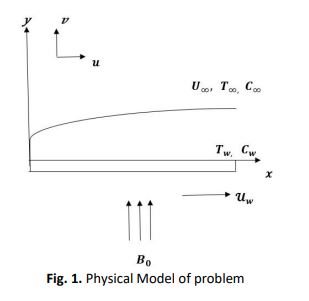Numerical Simulation of Boundary Layer Flow over a Moving Plate in the Presence of Magnetic Field and Slip Conditions
DOI:
https://doi.org/10.37934/arfmts.95.2.120136Keywords:
Nanofluids, slip conditions, MHD, viscous dissipation, moving plateAbstract
This study demonstrates the viscous flow of nanofluids under the influence of magnetic field and slip conditions over the boundary layer in a moving plate. By applying appropriate similarity variables to the governing partial differential equations, a similarity transformation is implemented to obtain the same as non-linear ordinary differential equations. The Transformed equations are then numerically solved by the finite difference method. Various parameters such as plate velocity parameter, slip parameters, thermophoresis parameter and Brownian motion parameter, Eckert number, Prandtl number and Lewis number are examined to study the properties of flow and heat transfer. The coefficient of skin friction, Nusselt number, and Sherwood numbers for selected parameters are numerically presented. Impact of MHD, slip conditions and viscous dissipation on nanofluid temperature, concentration and velocity profiles are determined and analyzed via graphs. This research reveals that the presence of magnetic field and viscous dissipation contributes to increase in temperature profile. Moreover, it is found that, when velocity slip increases, the temperature profile increases while the velocity profile decreases. It thickens the concentration boundary layer as well. This work may find its significant applications in high temperature and cooling processes, space technology, paints, medicines, conductive coatings, cosmetics and bio-sensors.
Downloads

































